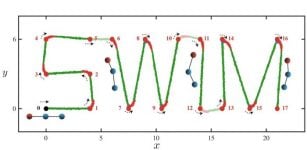3D Concrete Printing Method That Captures Carbon Dioxide
Eddie Gonzales Jr. – MessageToEagle.com – Scientists at Nanyang Technological University, Singapore, have developed a 3D concrete printing method that captures carbon, offering a new way to reduce the construction industry’s environmental impact.
A conrete wall (sample) constructed using the newly developed 3D concrete printing method. Credit: NTU Singapore
The method described in Carbon Capture Science & Technology aims to significantly reduce cement’s carbon footprint—a material responsible for 1. 6 billion metric tonnes of CO2 or about 8% of global emissions—by lowering material usage, construction time, and labor requirements.
The new 3D concrete printing process injects steam and CO2, captured from industrial by-products, into the mixing concrete. This method enhances the mechanical properties and increases strength compared to conventional 3D printed concrete.
Principal investigator of the study, Professor Tan Ming Jen from NTU School of Mechanical and Aerospace Engineering (MAE), and NTU’s Singapore Centre for 3D Printing (SC3DP), said that “the building and construction sector causes a significant portion of global greenhouse gas emissions.
“Our newly developed 3D concrete printing system offers a carbon reducing alternative by not only improving the mechanical properties of concrete but also contributing to reducing the sector’s environmental impact. It demonstrates the possibility of using CO2 produced by power plants or other industries for 3D concrete printing. Since traditional cement emits a lot of carbon, our method offers a way to plough back CO2 through 3D concrete printing.”
The research team believes their innovation represents a promising contribution towards achieving global sustainable development goals and reducing the industry’s reliance on conventional energy-intensive processes like reinforced concrete construction.
The new development builds on previous 3D printing for construction research by Prof Tan and his team at NTU’s SC3DP, as well as international collaborators.
Improved printability, increased strength and more carbon captured
To develop their 3D concrete printing system, the research team connected the 3D printer to CO2 pumps and a jet that sprays steam.
When activated, the system pumps CO2 and steam into the concrete mix as the structure is printed. CO2 reacts with the components in the concrete, turning into a solid form that stays locked inside the material (sequestered and stored).
At the same time, steam improves the absorption of CO2 into the 3D printed structure, enhancing its properties.
In lab tests, researchers found the printed concrete structure showed a 50 per cent improvement in printability – meaning it can be shaped and printed more efficiently.
The structure also displayed better strength and durability. The printed concrete was up to 36.8 per cent stronger in compression (how much weight it can bear) and up to 45.3 per cent stronger in bending (how much it can flex before breaking) compared to regular 3D printed concrete.
Notably, the method is also greener, absorbing and trapping 38 per cent more carbon dioxide compared to traditional 3D printing methods.
First author Lim Sean Gip, PhD candidate from NTU School of MAE, said, “We are at a critical time where the world is accelerating efforts to meet climate change targets. We believe our technology could contribute to making the construction industry more
sustainable.”
Co-author, Dr Daniel Tay, Research Fellow from NTU School of MAE, said, “Our proposed system shows how capturing carbon dioxide and using it in 3D concrete printing could lead to stronger, more eco-friendly buildings, advancing construction technology.”
A US patent application for the innovation has been filed jointly by NTU and collaborators. In future research, the researchers plan to optimise the 3D printing process to make it even more efficient and potentially use waste gases instead of pure carbon dioxide.
Written by Eddie Gonzales Jr. – MessageToEagle.com Staff Writer











